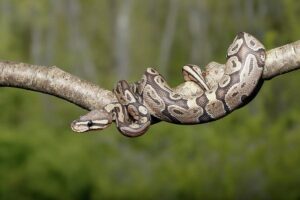Exploring the natural behaviors of ball pythons is essential for providing optimal care. Among the questions frequently asked by snake enthusiasts is, ‘Do ball pythons like to climb?’ Understanding this aspect of their behavior can help ensure their well-being in captivity.
Ball pythons are not natural climbers like some other snake species. In the wild, they spend most of their time on the ground, hiding in burrows or beneath vegetation. However, this doesn’t mean they won’t climb at all. In captivity, some ball pythons may occasionally climb on branches or other structures in their enclosure if provided.
Providing a variety of environmental enrichments, including branches and other climbing opportunities, can help satisfy their natural curiosity and behavioral needs. Ultimately, while not avid climbers, ball pythons may still appreciate the occasional opportunity to explore vertically.
Physical characteristics of ball pythons

Ball pythons (Python regius) are a popular species of snake in the pet trade known for their docile nature, manageable size, and beautiful coloration. Here are some of their physical characteristics:
- Size: Ball pythons are relatively small compared to other python species, typically ranging from 3 to 5 feet in length, although some individuals may grow slightly larger.
- Body: They have a stout, heavy-bodied build with a relatively small head compared to their body size.
- Coloration and Patterns: Ball pythons are known for their striking coloration and patterns. They have a base color that can vary from shades of brown to black, with lighter coloration on their bellies. Their patterns consist of irregular blotches or “balls” along their back and sides, which give them their name.
- Eyes: Their eyes are medium-sized and have vertically slit pupils, typical of nocturnal hunters.
- Scales: Like all snakes, ball pythons have scales covering their entire body. These scales can be smooth to the touch.
- Tail: Ball pythons have relatively short tails compared to their body length.
- Sexual dimorphism: Males tend to have longer and thicker tails compared to females of the same size. Additionally, males generally have larger spurs (vestigial hind limbs) near their vent, which are used during mating.
- Variations: There are many selectively bred color and pattern variations of ball pythons available in the pet trade, known as morphs. These morphs can include variations in color, pattern, and scale appearance. Some popular morphs include albino, pied, pastel, and clown.


